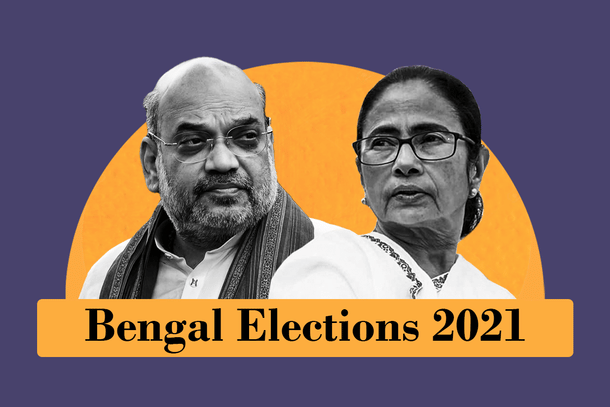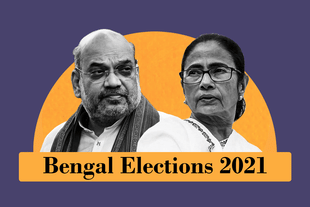Politics
In Maps: Key Takeaways From The West Bengal Assembly Elections
Venu Gopal Narayanan
May 06, 2021, 01:25 PM | Updated 01:25 PM IST
Save & read from anywhere!
Bookmark stories for easy access on any device or the Swarajya app.


The Trinamool Congress’s (TMC) second consecutive landslide victory in West Bengal has given rise to two schools of thought. One says that the Bharatiya Janata Party (BJP) flopped miserably, while the other interprets this verdict, along with those in Tamil Nadu and Kerala, as the starting point of a meaningful pan-Indian alternative to the BJP.
The electoral data though tells a different story. Here are the raw numbers:
(Note: The figures of the Left and the Congress have been combined for consistency, since they contested in alliance in 2021; two seats are to be re-polled later in the month; the 2019 seats are assembly segments of Lok Sabha constituencies)
Enough has already been written about the utter, irreversible decimation of the Left and the Congress in West Bengal, to merit further elaboration here; both parties have been wiped out of the state’s political space, and will not return – at least not in their current avatars. That space has been fully and formally taken up by the BJP.
What’s most intriguing is that there has been negligible transfer of votes between the TMC and the BJP. It is as if both sides consolidated their bases quite thoroughly and decisively, in two stages, at the cost of the Left and the Congress.
The bulk of that demolition job was executed by the BJP in 2019. The remainder was effected by the TMC in 2021, by taking four more per cent of the combined Congress-Left vote base. Oddly, votes still didn’t shift between the BJP and the TMC in 2021 either; rather, the BJP lost a little over 2 per cent of the vote to others – a crucial loss.
This same lack of vote transfer between the TMC and the BJP is seen if we compare the 2021 figures with the 2016 assembly elections. Then too, the BJP gains heavily from the Left and the Congress, and almost only them, while the TMC takes a tiny cut from the latter, and about as much from the others.
Either way, the TMC’s vote share has gone up by 3 to 4 per cent, depending upon which benchmark we use (2016 or 2019), and that has made all the difference. If the TMC’s vote share had gone down by even a percentage point or two, to the BJP, then the story would have been extremely different.
We can see how that lack of transfer worked to the TMC’s advantage, in a phase-wise plot of seats won:
Starting from behind, the BJP (orange curve) stayed below the TMC (green curve), after a third phase debacle sent their trajectory into a taper. On the face of it, it seemed like Prashant Kishor had been proved right – that the BJP wouldn’t cross into three figures.
Yet, as the next plot shows, the actual story of the 2021 assembly elections is that the BJP has made spectacular inroads into Dalit ranks:
Of the eighty reserved seats in the state which went to the polls, the two parties won roughly half each, with the trend staying neck-and-neck from the first phase to the last. Indeed, the BJP won more reserved seats than the TMC in five out of the eight phases. And significantly, the 38 reserved seats the BJP won in 2021 are fully half of the 77 seats they won in total.
Swarajya predicted this in March 2021; that, the BJP’s success would be a function of the extent to which it manages to break the TMC’s formidable Muslim-Dalit axis, especially in the two Parganas.
In the end, the results show that the BJP was unable to do that this time. Instead, it did as well as it has, in large part, because of the shift of the non-TMC Dalit vote to the BJP. We can see that clearly, in the two phases in which the BJP fared most poorly.
A map of phase three below, shows the extent to which the TMC managed to stem the BJP’s surge in Hugli, Howrah, and South 24 Parganas. The colour scheme is blues for BJP and browns for the TMC. The darker the browns, the heavier the TMC’s victory margin in a seat:
The overall picture is given in a final map below, showing the BJP’s win/loss margins across the state. The colour scheme is weighted for magnitude of victory; the darker the blue, the higher the BJP’s win margin; the darker the brown, the higher the TMC’s win margin.
Yellows indicate a narrow BJP win, and pinks and reds the same for the TMC. We see that the bulk of the TMC’s close calls are in BJP-dominant or BJP-ascendant areas.
Today, the BJP has fully occupied the entire opposition space in West Bengal, largely by attracting those votes which had traditionally been with the Congress and the Left. As yet, they have been unable to dent the TMC’s Dalit-Muslim axis, since no material vote transfer has taken place between the two parties.
Now, Prashant Kishor may term this as a failure of the BJP, and childishly gloat that he is a better political strategist than Amit Shah. TMC MP Derek O’Brien may ingeniously make ignoble light of the post-poll violence unleashed by TMC mobs, and use the verdict to claim the moral high ground.
Mainstream media commentators, giddy with delight at the BJP’s ‘loss’, might declare the 2021 verdict as a paradigmatic fulcrum, upon which the opposition’s fortunes are now set to joyously swivel. Fair enough; that is their prerogative. But they would also do well to look at Chart 2, and understand that the BJP’s aims go far beyond mere numbers.
Many believe that 2014 was a fateful turning point, which was gloriously reversed in part by the 2021 results. They’re mistaken; the present round of assembly elections hasn’t thrown up an alternative to the BJP, as much as it has established the crying need for alternative options in the opposition space.
That means the actual turning point is still an election cycle or two away, after the BJP has drained the swamp of ideological detritus, after the first, material reclamation of our civilisational ethos has been instituted, and, when a durable, nationalistic alternative to the BJP finally emerges, by the vote. And ironically, neither Kishor nor O’Brien will be a part of that political space.
This is the true significance of the West Bengal verdict.
All data from Election Commission of India website
Venu Gopal Narayanan is an independent upstream petroleum consultant who focuses on energy, geopolitics, current affairs and electoral arithmetic. He tweets at @ideorogue.





